fuel cap MERCEDES-BENZ B-CLASS 2012 Owners Manual
[x] Cancel search | Manufacturer: MERCEDES-BENZ, Model Year: 2012, Model line: B-CLASS, Model: MERCEDES-BENZ B-CLASS 2012Pages: 340, PDF Size: 3.09 MB
Page 11 of 340
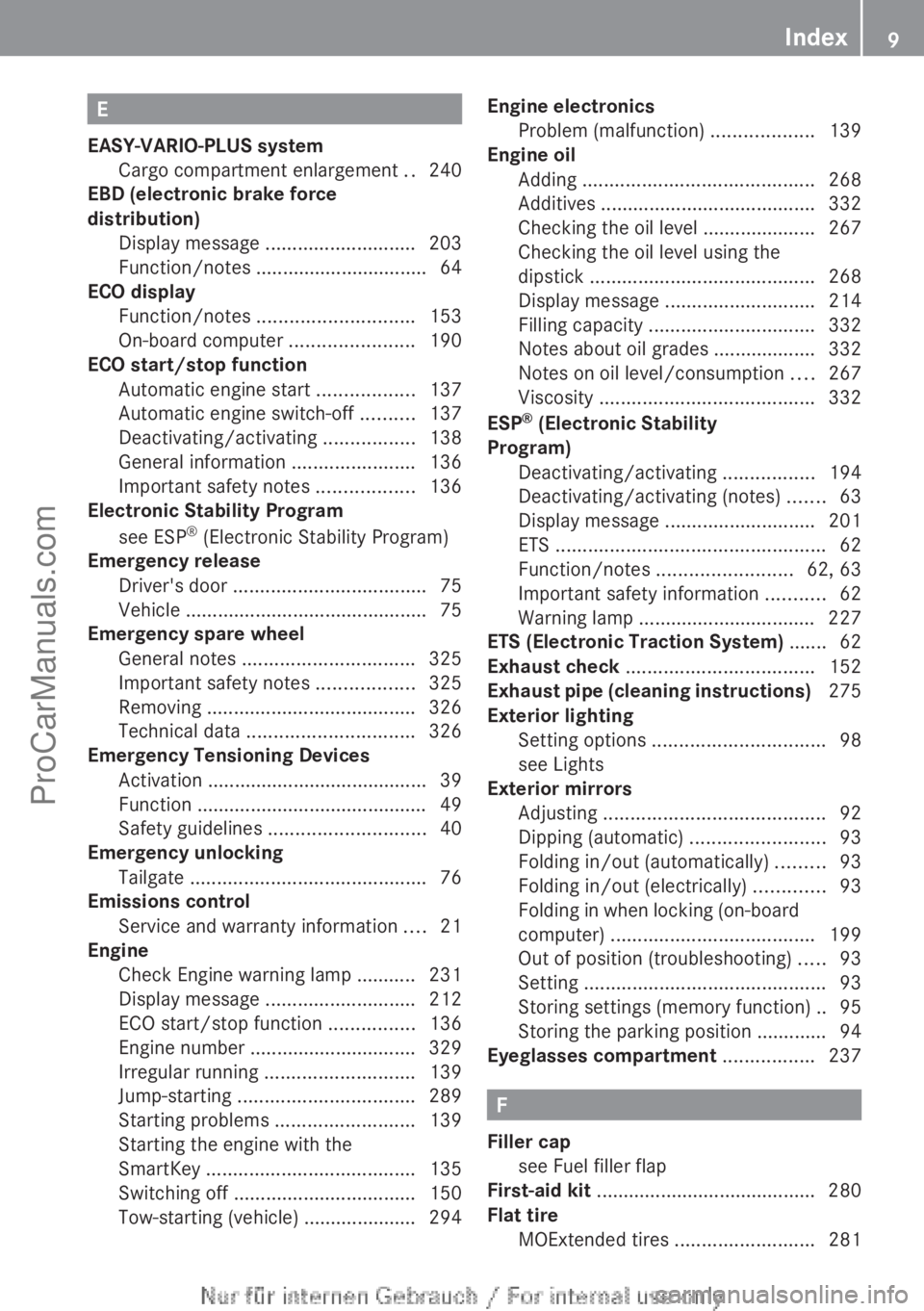
E
EASY-VARIO-PLUS system Cargo compartment enlargement ..240
EBD (electronic brake force
distribution)
Display message ............................ 203
Function/notes ................................
64
ECO display
Function/notes ............................. 153
On-board computer ....................... 190
ECO start/stop function
Automatic engine start .................. 137
Automatic engine switch-off .......... 137
Deactivating/activating ................. 138
General information ....................... 136
Important safety notes .................. 136
Electronic Stability Program
see ESP ®
(Electronic Stability Program)
Emergency release
Driver's door .................................... 75
Vehicle ............................................. 75
Emergency spare wheel
General notes ................................ 325
Important safety notes .................. 325
Removing ....................................... 326
Technical data ............................... 326
Emergency Tensioning Devices
Activation ......................................... 39
Function ........................................... 49
Safety guidelines ............................. 40
Emergency unlocking
Tailgate ............................................ 76
Emissions control
Service and warranty information .... 21
Engine
Check Engine warning lamp ........... 231
Display message ............................ 212
ECO start/stop function ................ 136
Engine number ............................... 329
Irregular running ............................ 139
Jump-starting ................................. 289
Starting problems .......................... 139
Starting the engine with the
SmartKey ....................................... 135
Switching off .................................. 150
Tow-starting (vehicle) ..................... 294 Engine electronics
Problem (malfunction) ...................139
Engine oil
Adding ........................................... 268
Additives ........................................ 332
Checking the oil level ..................... 267
Checking the oil level using the
dipstick
.......................................... 268
Display message ............................ 214
Filling capacity ............................... 332
Notes about oil grades ................... 332
Notes on oil level/consumption .... 267
Viscosity ........................................ 332
ESP ®
(Electronic Stability
Program) Deactivating/activating ................. 194
Deactivating/activating (notes) ....... 63
Display message ............................ 201
ETS .................................................. 62
Function/notes ......................... 62, 63
Important safety information ........... 62
Warning lamp ................................. 227
ETS (Electronic Traction System) ....... 62
Exhaust check ................................... 152
Exhaust pipe (cleaning instructions) 275
Exterior lighting Setting options ................................ 98
see Lights
Exterior mirrors
Adjusting ......................................... 92
Dipping (automatic) .........................93
Folding in/out (automatically) ......... 93
Folding in/out (electrically) ............. 93
Folding in when locking (on-board
computer) ...................................... 199
Out of position (troubleshooting) .....93
Setting ............................................. 93
Storing settings (memory function) .. 95
Storing the parking position ............. 94
Eyeglasses compartment ................. 237 F
Filler cap see Fuel filler flap
First-aid kit ......................................... 280
Flat tire MOExtended tires .......................... 281 Index
9
ProCarManuals.com
Page 12 of 340
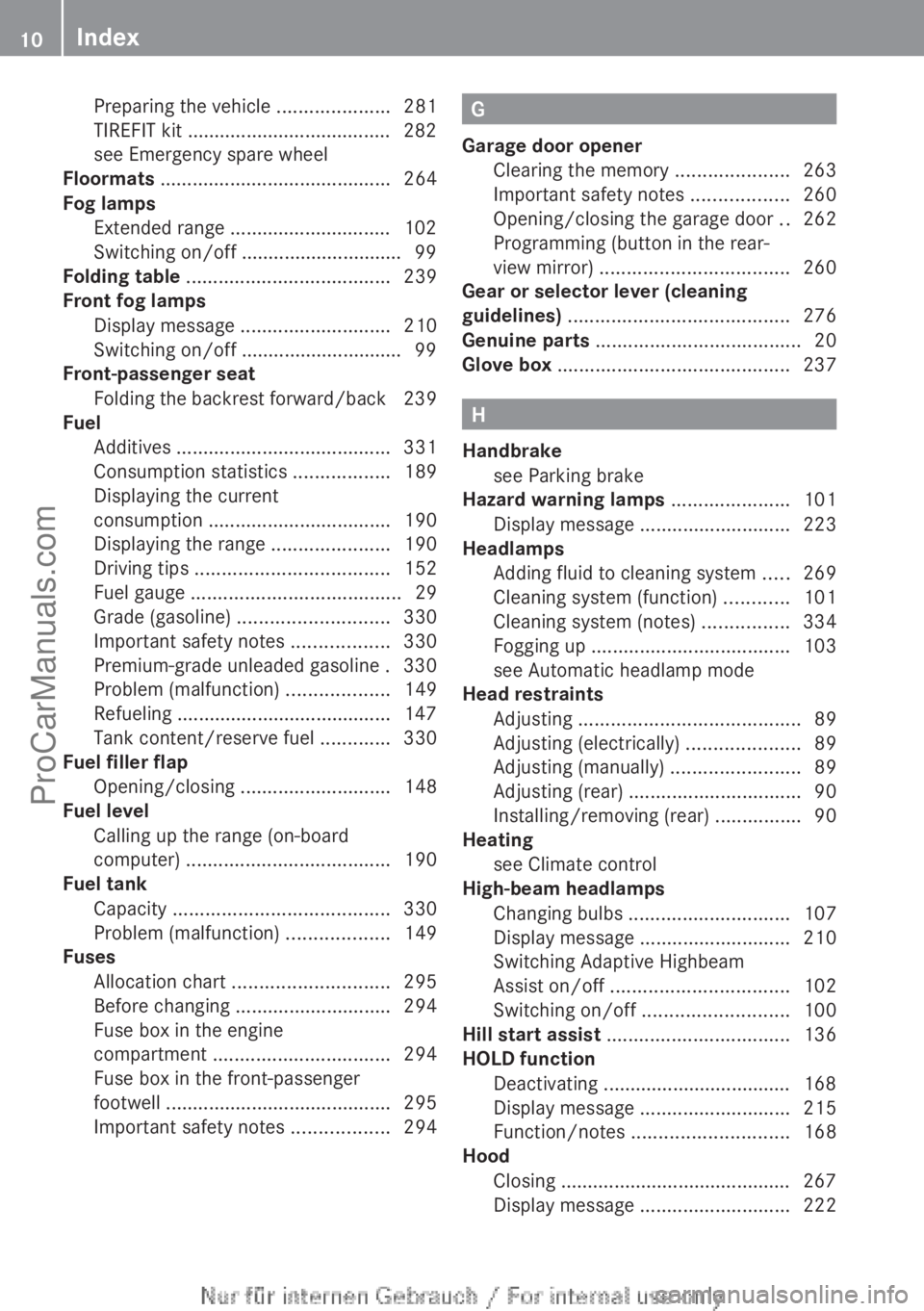
Preparing the vehicle
.....................281
TIREFIT kit ...................................... 282
see Emergency spare wheel
Floormats ........................................... 264
Fog lamps Extended range .............................. 102
Switching on/off .............................. 99
Folding table ...................................... 239
Front fog lamps Display message ............................ 210
Switching on/off .............................. 99
Front-passenger seat
Folding the backrest forward/back 239
Fuel
Additives ........................................ 331
Consumption statistics ..................189
Displaying the current
consumption .................................. 190
Displaying the range ...................... 190
Driving tips .................................... 152
Fuel gauge ....................................... 29
Grade (gasoline) ............................ 330
Important safety notes .................. 330
Premium-grade unleaded gasoline . 330
Problem (malfunction) ...................149
Refueling ........................................ 147
Tank content/reserve fuel .............330
Fuel filler flap
Opening/closing ............................ 148
Fuel level
Calling up the range (on-board
computer) ...................................... 190
Fuel tank
Capacity ........................................ 330
Problem (malfunction) ...................149
Fuses
Allocation chart ............................. 295
Before changing ............................. 294
Fuse box in the engine
compartment ................................. 294
Fuse box in the front-passenger
footwell .......................................... 295
Important safety notes .................. 294 G
Garage door opener Clearing the memory ..................... 263
Important safety notes
..................260
Opening/closing the garage door ..262
Programming (button in the rear-
view mirror) ................................... 260
Gear or selector lever (cleaning
guidelines) ......................................... 276
Genuine parts ...................................... 20
Glove box ........................................... 237 H
Handbrake see Parking brake
Hazard warning lamps ......................101
Display message ............................ 223
Headlamps
Adding fluid to cleaning system .....269
Cleaning system (function) ............ 101
Cleaning system (notes) ................334
Fogging up ..................................... 103
see Automatic headlamp mode
Head restraints
Adjusting ......................................... 89
Adjusting (electrically) .....................89
Adjusting (manually) ........................ 89
Adjusting (rear) ................................ 90
Installing/removing (rear) ................ 90
Heating
see Climate control
High-beam headlamps
Changing bulbs .............................. 107
Display message ............................ 210
Switching Adaptive Highbeam
Assist on/off ................................. 102
Switching on/off ........................... 100
Hill start assist .................................. 136
HOLD function Deactivating ................................... 168
Display message ............................ 215
Function/notes ............................. 168
Hood
Closing ........................................... 267
Display message ............................ 22210
Index
ProCarManuals.com
Page 18 of 340
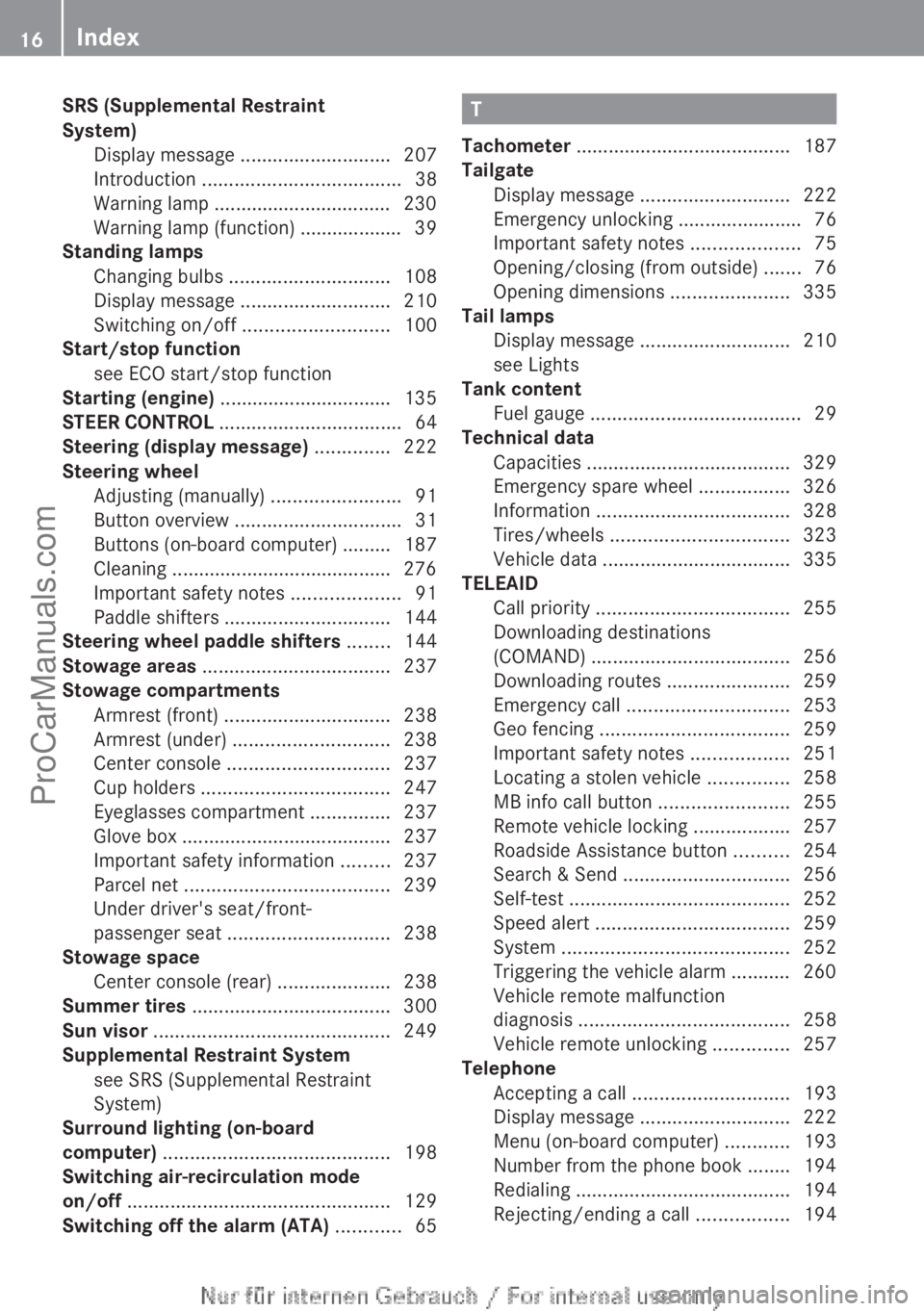
SRS (Supplemental Restraint
System)
Display message ............................ 207
Introduction
..................................... 38
Warning lamp ................................. 230
Warning lamp (function) ................... 39
Standing lamps
Changing bulbs .............................. 108
Display message ............................ 210
Switching on/off ........................... 100
Start/stop function
see ECO start/stop function
Starting (engine) ................................ 135
STEER CONTROL .................................. 64
Steering (display message) ..............222
Steering wheel Adjusting (manually) ........................ 91
Button overview ............................... 31
Buttons (on-board computer) ......... 187
Cleaning ......................................... 276
Important safety notes .................... 91
Paddle shifters ............................... 144
Steering wheel paddle shifters ........144
Stowage areas ................................... 237
Stowage compartments Armrest (front) ............................... 238
Armrest (under) ............................. 238
Center console .............................. 237
Cup holders ................................... 247
Eyeglasses compartment ............... 237
Glove box ....................................... 237
Important safety information ......... 237
Parcel net ...................................... 239
Under driver's seat/front-
passenger seat .............................. 238
Stowage space
Center console (rear) ..................... 238
Summer tires ..................................... 300
Sun visor ............................................ 249
Supplemental Restraint System see SRS (Supplemental Restraint
System)
Surround lighting (on-board
computer) .......................................... 198
Switching air-recirculation mode
on/off ................................................. 129
Switching off the alarm (ATA) ............65 T
Tachometer ........................................ 187
Tailgate Display message ............................ 222
Emergency unlocking .......................76
Important safety notes
....................75
Opening/closing (from outside) ....... 76
Opening dimensions ...................... 335
Tail lamps
Display message ............................ 210
see Lights
Tank content
Fuel gauge ....................................... 29
Technical data
Capacities ...................................... 329
Emergency spare wheel ................. 326
Information .................................... 328
Tires/wheels ................................. 323
Vehicle data ................................... 335
TELEAID
Call priority .................................... 255
Downloading destinations
(COMAND) ..................................... 256
Downloading routes .......................259
Emergency call .............................. 253
Geo fencing ................................... 259
Important safety notes .................. 251
Locating a stolen vehicle ............... 258
MB info call button ........................ 255
Remote vehicle locking .................. 257
Roadside Assistance button .......... 254
Search & Send ............................... 256
Self-test ......................................... 252
Speed alert .................................... 259
System .......................................... 252
Triggering the vehicle alarm ........... 260
Vehicle remote malfunction
diagnosis ....................................... 258
Vehicle remote unlocking .............. 257
Telephone
Accepting a call ............................. 193
Display message ............................ 222
Menu (on-board computer) ............ 193
Number from the phone book ........ 194
Redialing ........................................ 194
Rejecting/ending a call ................. 19416
Index
ProCarManuals.com
Page 150 of 340
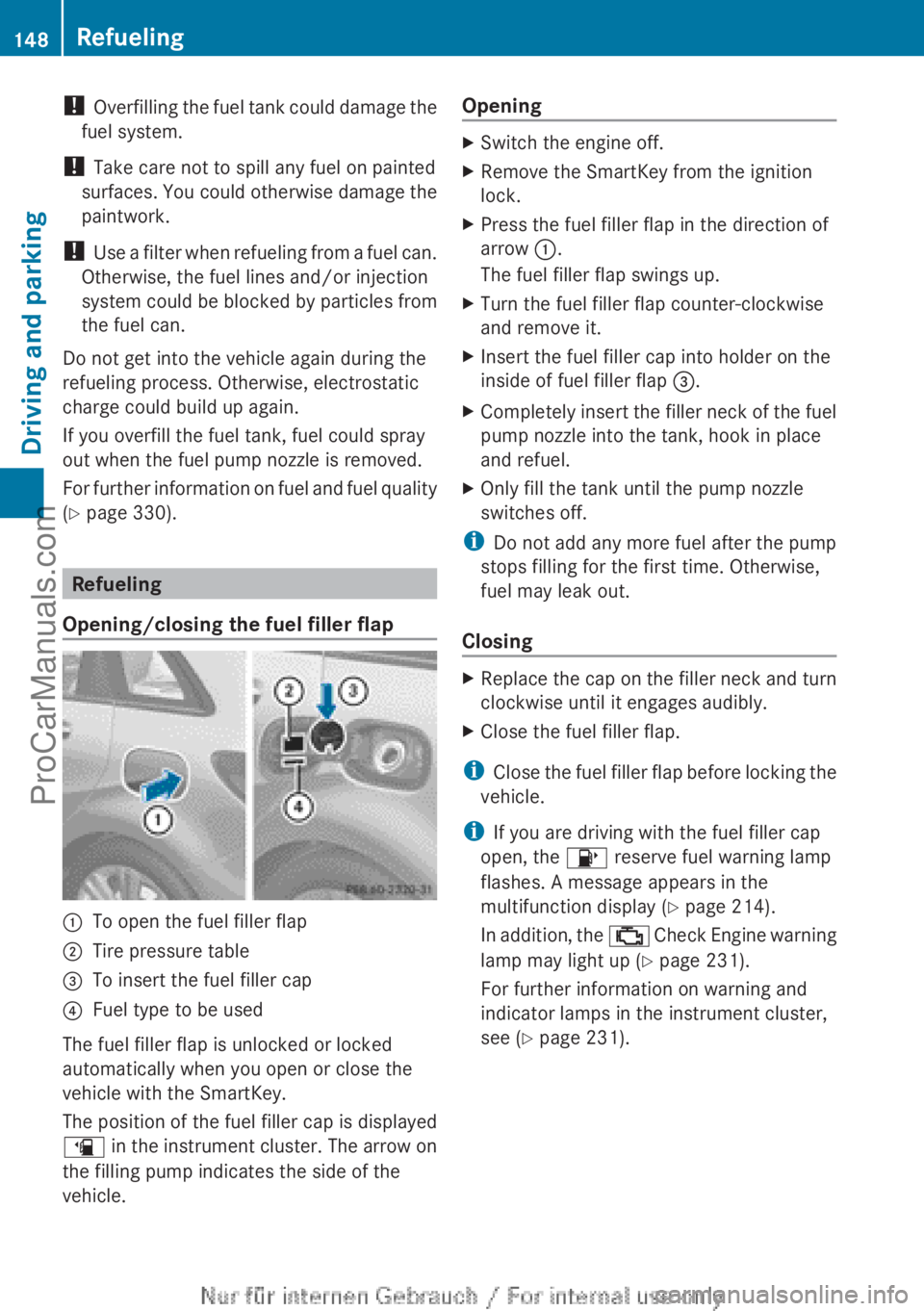
!
Overfilling the fuel
tank could damage the
fuel system.
! Take care not to spill any fuel on painted
surfaces. You could otherwise damage the
paintwork.
! Use a filter when refueling from a fuel can.
Otherwise, the fuel lines and/or injection
system could be blocked by particles from
the fuel can.
Do not get into the vehicle again during the
refueling process. Otherwise, electrostatic
charge could build up again.
If you overfill the fuel tank, fuel could spray
out when the fuel pump nozzle is removed.
For further information on fuel and fuel quality
(Y page 330). Refueling
Opening/closing the fuel filler flap :
To open the fuel filler flap
; Tire pressure table
= To insert the fuel filler cap
? Fuel type to be used
The fuel filler flap is unlocked or locked
automatically when you open or close the
vehicle with the SmartKey.
The position of the fuel filler cap is displayed
æ in
the
instrument cluster. The arrow on
the filling pump indicates the side of the
vehicle. Opening X
Switch the engine off.
X Remove the SmartKey from the ignition
lock.
X Press the fuel filler flap in the direction of
arrow :.
The fuel filler flap swings up.
X Turn the fuel filler flap counter-clockwise
and remove it.
X Insert the fuel filler cap into holder on the
inside of fuel filler flap =.
X Completely insert the filler neck of the fuel
pump nozzle into the tank, hook in place
and refuel.
X Only fill the tank until the pump nozzle
switches off.
i Do not add any more fuel after the pump
stops filling for the first time. Otherwise,
fuel may leak out.
Closing X
Replace the cap on the filler neck and turn
clockwise until it engages audibly.
X Close the fuel filler flap.
i Close the fuel
filler flap before locking the
vehicle.
i If you are driving with the fuel filler cap
open, the 8 reserve fuel warning lamp
flashes. A message appears in the
multifunction display ( Y page 214).
In addition, the ; Check Engine warning
lamp may light up ( Y page 231).
For further information on warning and
indicator lamps in the instrument cluster,
see ( Y page 231).148
Refueling
Driving and parking
ProCarManuals.com
Page 216 of 340
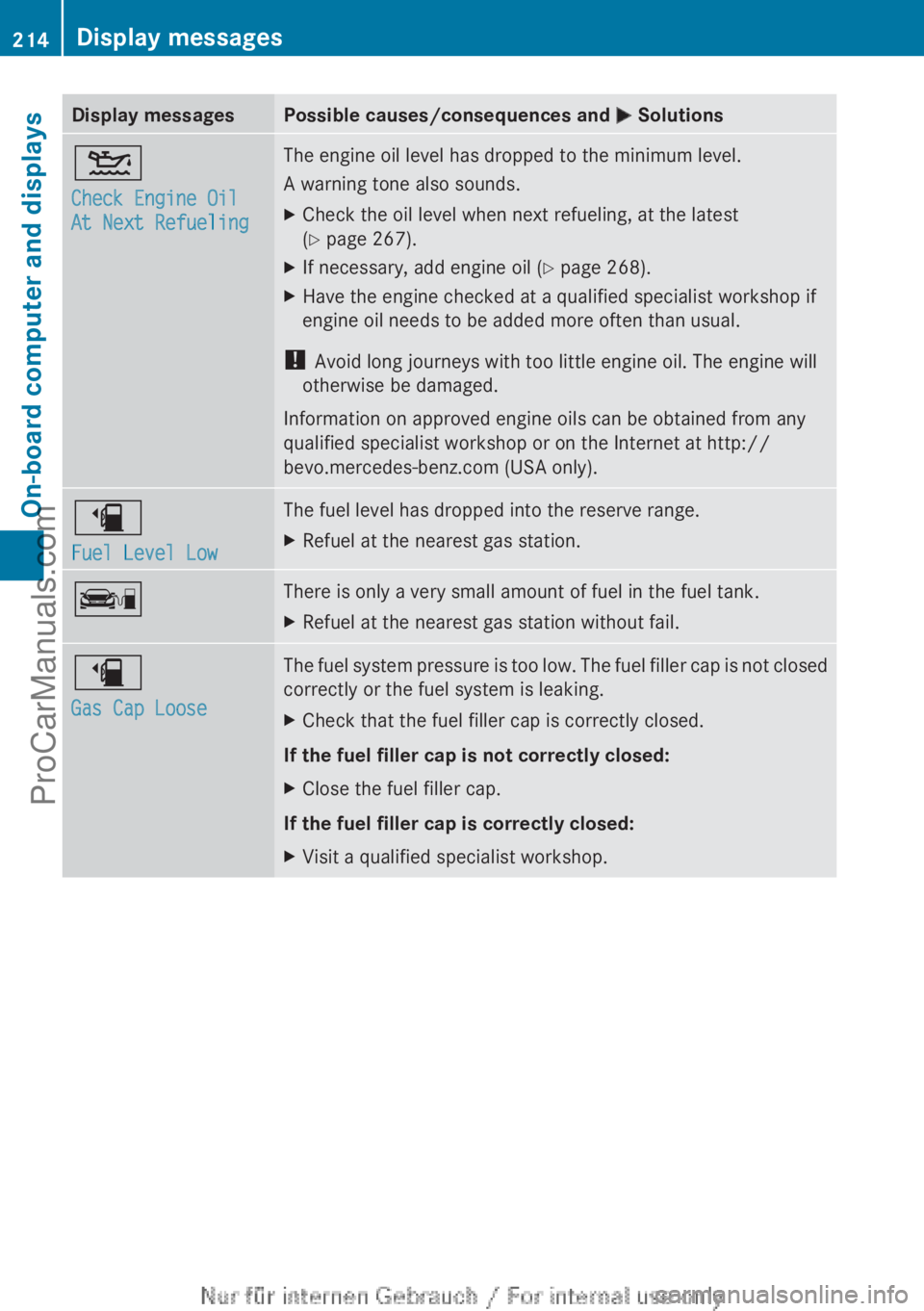
Display messages Possible causes/consequences and
M Solutions4
Check Engine Oil
At Next Refueling The engine oil level has dropped to the minimum level.
A warning tone also sounds.
X
Check the oil level when next refueling, at the latest
(Y page 267).
X If necessary, add engine oil ( Y page 268).
X Have the engine checked at a qualified specialist workshop if
engine oil needs to be added more often than usual.
! Avoid long journeys with too little engine oil. The engine will
otherwise be damaged.
Information on approved engine oils can be obtained from any
qualified specialist workshop or on the Internet at http://
bevo.mercedes-benz.com (USA only). æ
Fuel Level Low The fuel level has dropped into the reserve range.
X
Refuel at the nearest gas station. ç There is only a very small amount of fuel in the fuel tank.
X
Refuel at the nearest gas station without fail. æ
Gas Cap Loose The fuel system pressure is too low. The fuel filler cap is not closed
correctly or the fuel system is leaking.
X
Check that the fuel filler cap is correctly closed.
If the fuel filler cap is not correctly closed:
X Close the fuel filler cap.
If the fuel filler cap is correctly closed:
X Visit a qualified specialist workshop.214
Display messagesOn-board computer and displays
ProCarManuals.com
Page 233 of 340
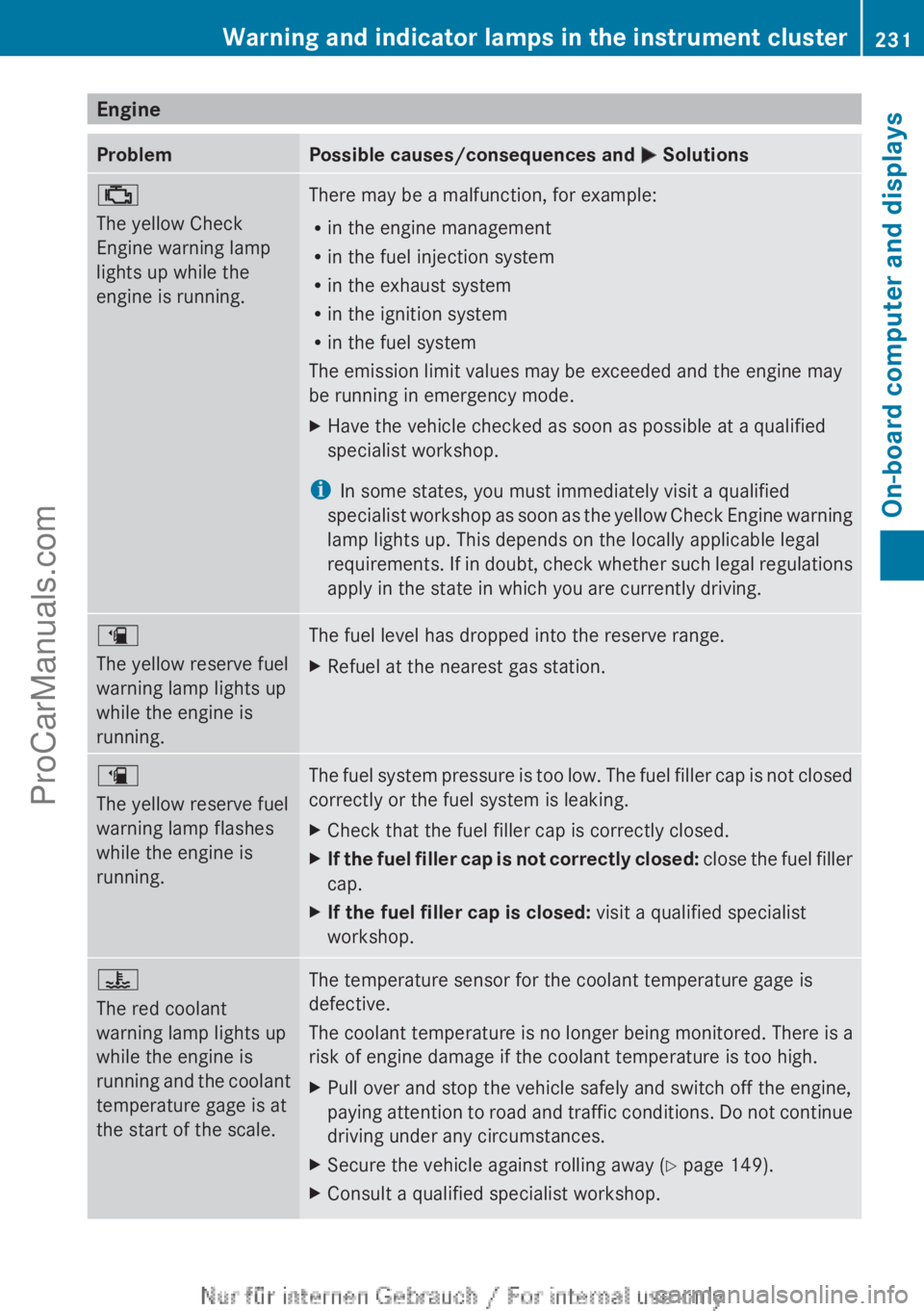
Engine
Problem Possible causes/consequences and
M Solutions;
The yellow Check
Engine warning lamp
lights up while the
engine is running.
There may be a malfunction, for example:
R
in the engine management
R in the fuel injection system
R in the exhaust system
R in the ignition system
R in the fuel system
The emission limit values may be exceeded and the engine may
be running in emergency mode.
X Have the vehicle checked as soon as possible at a qualified
specialist workshop.
i In some states, you must immediately visit a qualified
specialist workshop as
soon as the yellow Check Engine warning
lamp lights up. This depends on the locally applicable legal
requirements. If in doubt, check whether such legal regulations
apply in the state in which you are currently driving. æ
The yellow reserve fuel
warning lamp lights up
while the engine is
running.
The fuel level has dropped into the reserve range.
X
Refuel at the nearest gas station. æ
The yellow reserve fuel
warning lamp flashes
while the engine is
running.
The fuel system pressure is too low. The fuel filler cap is not closed
correctly or the fuel system is leaking.
X
Check that the fuel filler cap is correctly closed.
X If the fuel filler cap is not correctly closed:
close the
fuel filler
cap.
X If the fuel filler cap is closed: visit a qualified specialist
workshop. ?
The red coolant
warning lamp lights up
while the engine is
running and
the
coolant
temperature gage is at
the start of the scale. The temperature sensor for the coolant temperature gage is
defective.
The coolant
temperature
is no longer being monitored. There is a
risk of engine damage if the coolant temperature is too high.
X Pull over and stop the vehicle safely and switch off the engine,
paying attention to
road and traffic conditions. Do not continue
driving under any circumstances.
X Secure the vehicle against rolling away ( Y page 149).
X Consult a qualified specialist workshop. Warning and indicator lamps in the instrument cluster
231
On-board computer and displays Z
ProCarManuals.com
Page 287 of 340
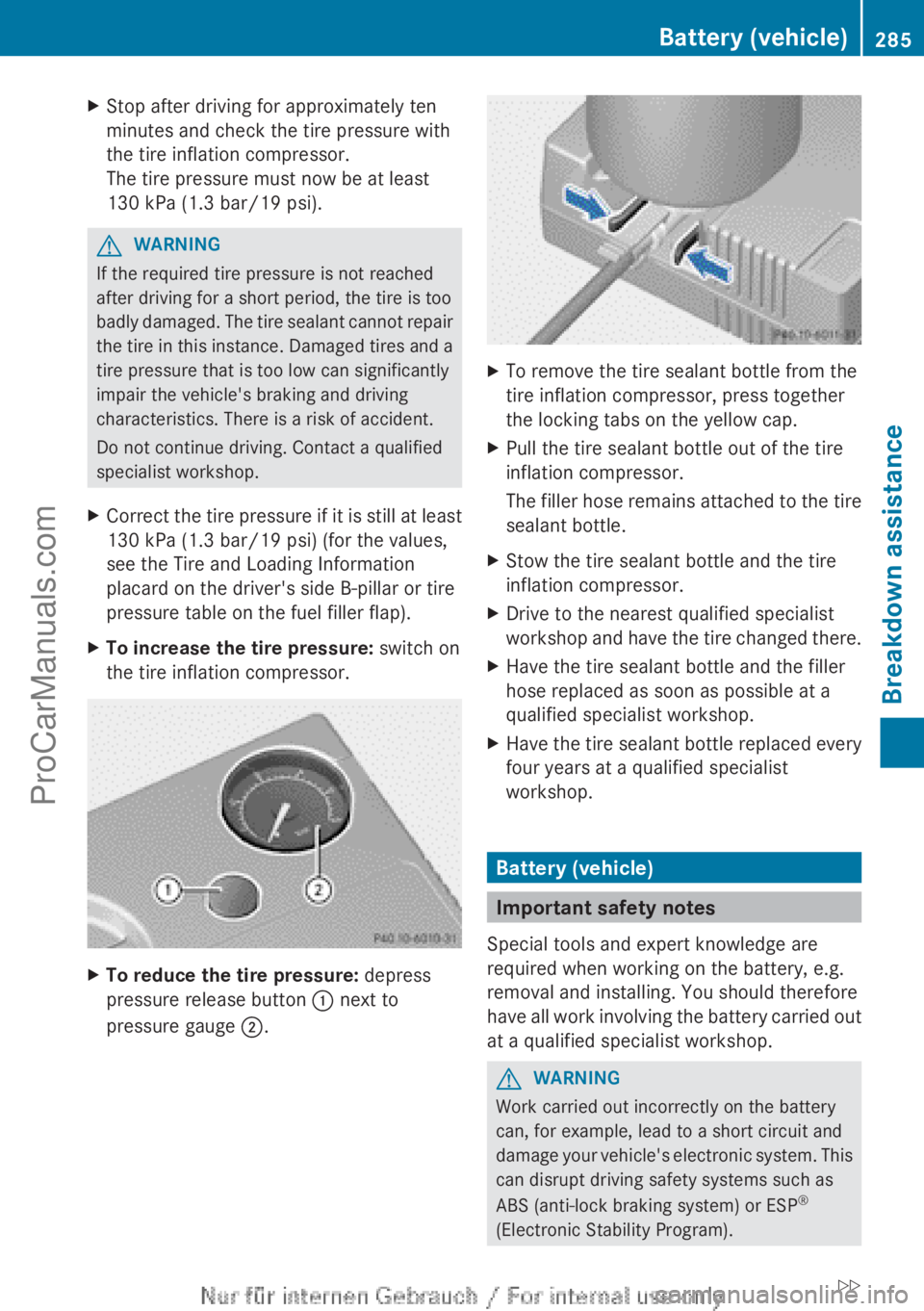
X
Stop after driving for approximately ten
minutes and check the tire pressure with
the tire inflation compressor.
The tire pressure must now be at least
130 kPa (1.3 bar/19 psi). G
WARNING
If the required tire pressure is not reached
after driving for a short period, the tire is too
badly damaged. The
tire sealant cannot repair
the tire in this instance. Damaged tires and a
tire pressure that is too low can significantly
impair the vehicle's braking and driving
characteristics. There is a risk of accident.
Do not continue driving. Contact a qualified
specialist workshop.
X Correct the tire pressure if it is still at least
130 kPa (1.3 bar/19 psi) (for the values,
see the Tire and Loading Information
placard on the driver's side B-pillar or tire
pressure table on the fuel filler flap).
X To increase the tire pressure: switch on
the tire inflation compressor. X
To reduce the tire pressure: depress
pressure release button : next to
pressure gauge ;. X
To remove the tire sealant bottle from the
tire inflation compressor, press together
the locking tabs on the yellow cap.
X Pull the tire sealant bottle out of the tire
inflation compressor.
The filler hose
remains attached to the tire
sealant bottle.
X Stow the tire sealant bottle and the tire
inflation compressor.
X Drive to the nearest qualified specialist
workshop and have
the tire changed there.
X Have the tire sealant bottle and the filler
hose replaced as soon as possible at a
qualified specialist workshop.
X Have the tire sealant bottle replaced every
four years at a qualified specialist
workshop. Battery (vehicle)
Important safety notes
Special tools and expert knowledge are
required when working on the battery, e.g.
removal and installing. You should therefore
have all work
involving the battery carried out
at a qualified specialist workshop. G
WARNING
Work carried out incorrectly on the battery
can, for example, lead to a short circuit and
damage your vehicle's
electronic system. This
can disrupt driving safety systems such as
ABS (anti-lock braking system) or ESP ®
(Electronic Stability Program). Battery (vehicle)
285
Breakdown assistance
ZProCarManuals.com
Page 291 of 340
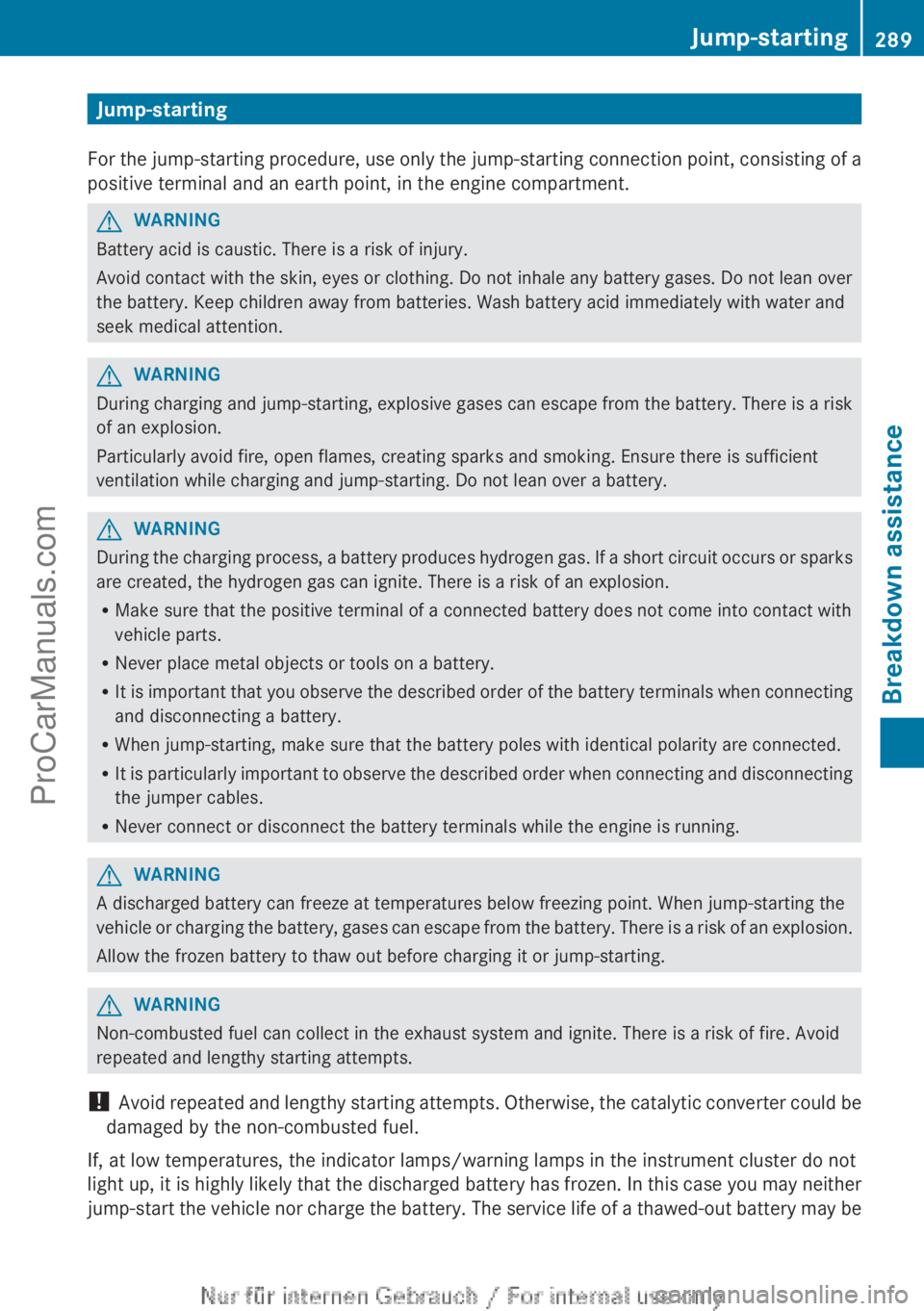
Jump-starting
For the jump-starting
procedure, use only the jump-starting connection point, consisting of a
positive terminal and an earth point, in the engine compartment. G
WARNING
Battery acid is caustic. There is a risk of injury.
Avoid contact with the skin, eyes or clothing. Do not inhale any battery gases. Do not lean over
the battery. Keep children away from batteries. Wash battery acid immediately with water and
seek medical attention. G
WARNING
During charging and jump-starting, explosive gases can escape from the battery. There is a risk
of an explosion.
Particularly avoid fire, open flames, creating sparks and smoking. Ensure there is sufficient
ventilation while charging and jump-starting. Do not lean over a battery. G
WARNING
During the charging process, a battery produces hydrogen gas. If a short circuit occurs or sparks
are created, the hydrogen gas can ignite. There is a risk of an explosion.
R Make sure that the positive terminal of a connected battery does not come into contact with
vehicle parts.
R Never place metal objects or tools on a battery.
R It is important
that you observe the described order of the battery terminals when connecting
and disconnecting a battery.
R When jump-starting, make sure that the battery poles with identical polarity are connected.
R It is particularly important to observe the described order when connecting and disconnecting
the jumper cables.
R Never connect or disconnect the battery terminals while the engine is running. G
WARNING
A discharged battery can freeze at temperatures below freezing point. When jump-starting the
vehicle or charging
the battery, gases can escape from the battery. There is a risk of an explosion.
Allow the frozen battery to thaw out before charging it or jump-starting. G
WARNING
Non-combusted fuel can collect in the exhaust system and ignite. There is a risk of fire. Avoid
repeated and lengthy starting attempts.
! Avoid repeated and
lengthy starting attempts. Otherwise, the catalytic converter could be
damaged by the non-combusted fuel.
If, at low temperatures, the indicator lamps/warning lamps in the instrument cluster do not
light up, it is highly likely that the discharged battery has frozen. In this case you may neither
jump-start the vehicle nor charge the battery. The service life of a thawed-out battery may be Jump-starting
289
Breakdown assistance Z
ProCarManuals.com
Page 307 of 340
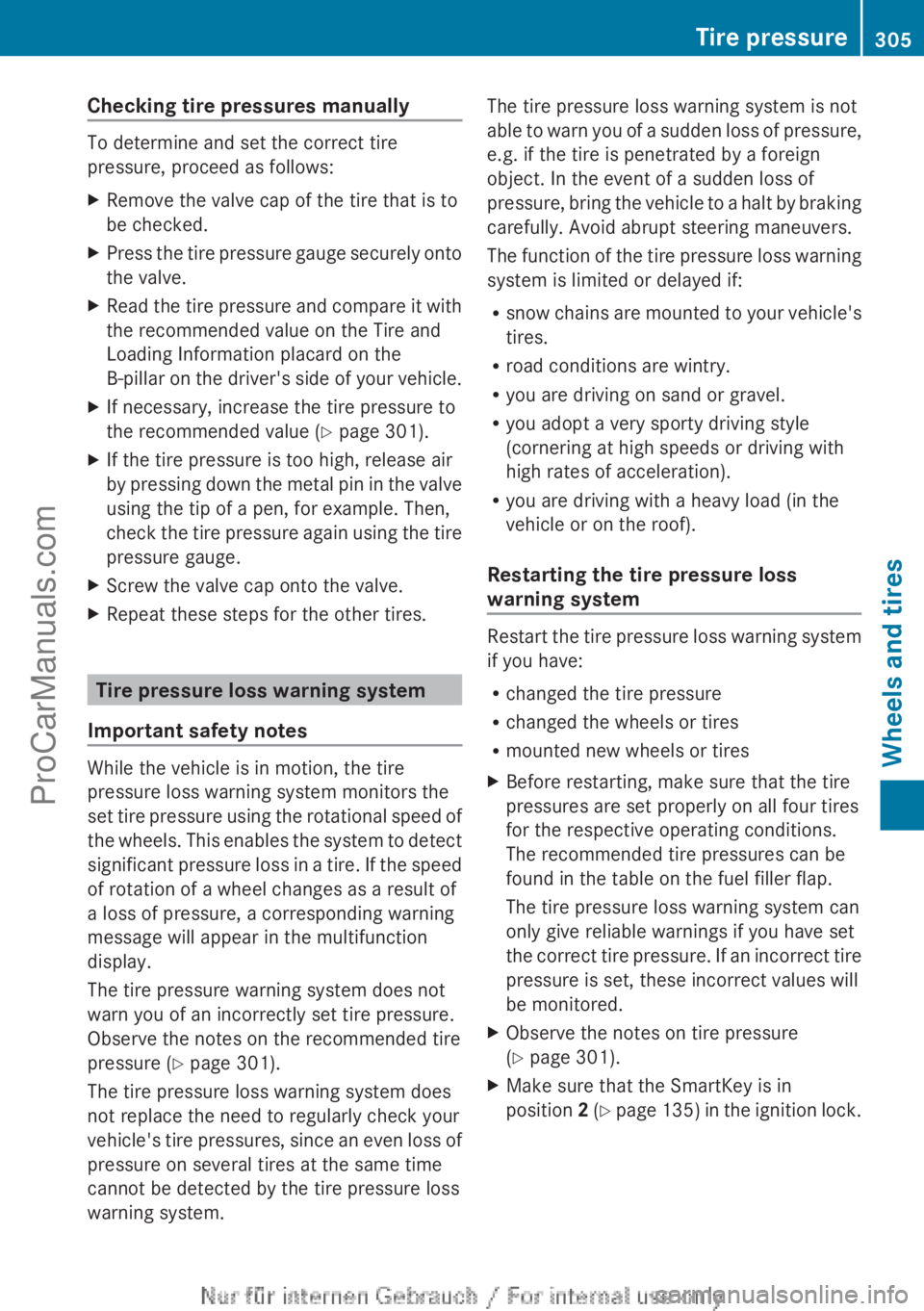
Checking tire pressures manually
To determine and set the correct tire
pressure, proceed as follows:
X
Remove the valve cap of the tire that is to
be checked.
X Press the tire pressure gauge securely onto
the valve.
X Read the tire pressure and compare it with
the recommended value on the Tire and
Loading Information placard on the
B-pillar on the
driver's side of your vehicle.
X If necessary, increase the tire pressure to
the recommended value ( Y page 301).
X If the tire pressure is too high, release air
by pressing down
the metal pin in the valve
using the tip of a pen, for example. Then,
check the tire pressure again using the tire
pressure gauge.
X Screw the valve cap onto the valve.
X Repeat these steps for the other tires. Tire pressure loss warning system
Important safety notes While the vehicle is in motion, the tire
pressure loss warning system monitors the
set
tire
pressure
using the rotational speed of
the wheels. This enables the system to detect
significant pressure loss in a tire. If the speed
of rotation of a wheel changes as a result of
a loss of pressure, a corresponding warning
message will appear in the multifunction
display.
The tire pressure warning system does not
warn you of an incorrectly set tire pressure.
Observe the notes on the recommended tire
pressure ( Y page 301).
The tire pressure loss warning system does
not replace the need to regularly check your
vehicle's tire pressures, since an even loss of
pressure on several tires at the same time
cannot be detected by the tire pressure loss
warning system. The tire pressure loss warning system is not
able to
warn
you of a sudden loss of pressure,
e.g. if the tire is penetrated by a foreign
object. In the event of a sudden loss of
pressure, bring the vehicle to a halt by braking
carefully. Avoid abrupt steering maneuvers.
The function of the tire pressure loss warning
system is limited or delayed if:
R snow chains are mounted to your vehicle's
tires.
R road conditions are wintry.
R you are driving on sand or gravel.
R you adopt a very sporty driving style
(cornering at high speeds or driving with
high rates of acceleration).
R you are driving with a heavy load (in the
vehicle or on the roof).
Restarting the tire pressure loss
warning system Restart the tire pressure loss warning system
if you have:
R
changed the tire pressure
R changed the wheels or tires
R mounted new wheels or tires
X Before restarting, make sure that the tire
pressures are set properly on all four tires
for the respective operating conditions.
The recommended tire pressures can be
found in the table on the fuel filler flap.
The tire pressure loss warning system can
only give reliable warnings if you have set
the correct tire
pressure. If an incorrect tire
pressure is set, these incorrect values will
be monitored.
X Observe the notes on tire pressure
(Y page 301).
X Make sure that the SmartKey is in
position 2 (Y page 135)
in the ignition lock. Tire pressure
305
Wheels and tires Z
ProCarManuals.com
Page 319 of 340
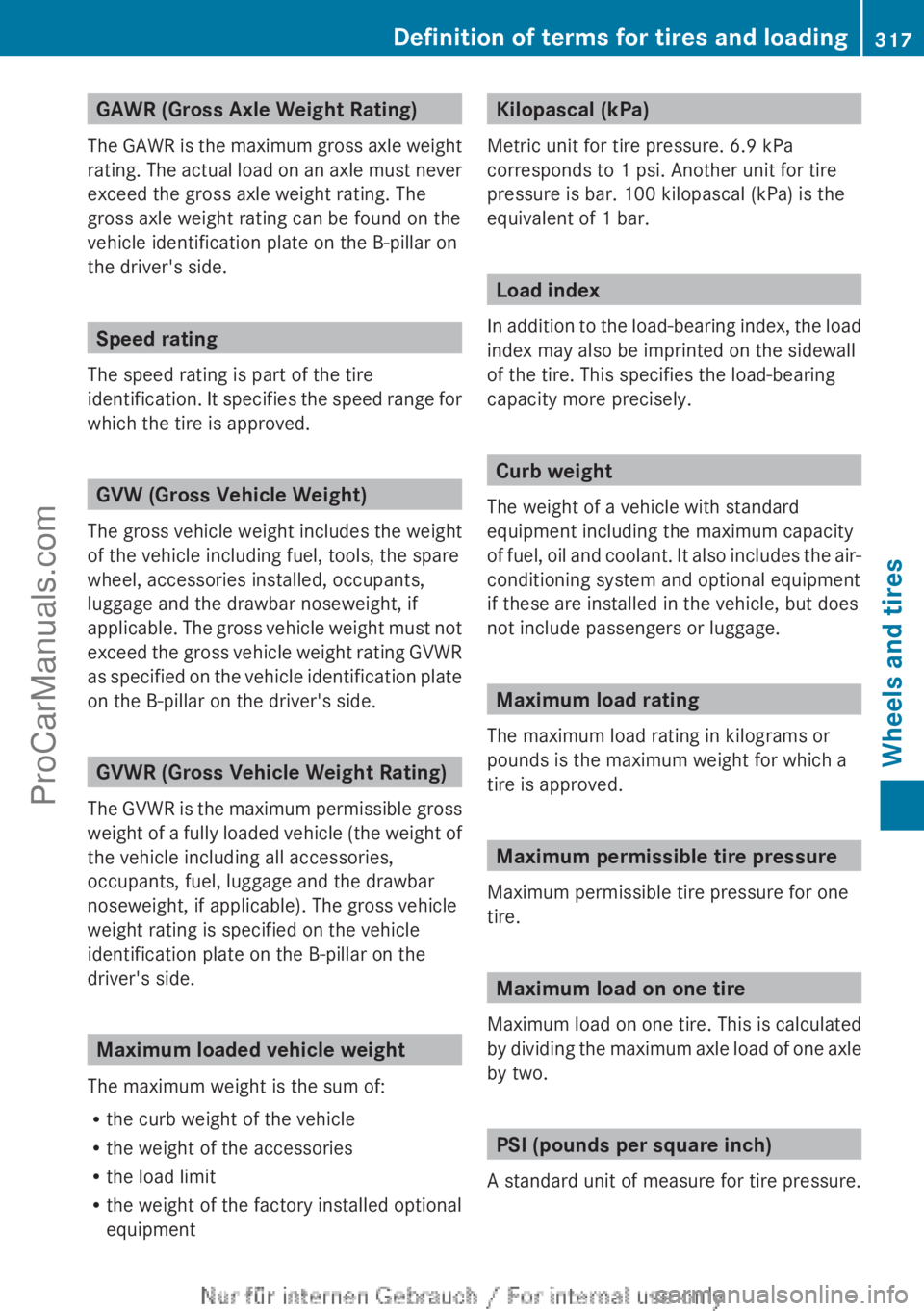
GAWR (Gross Axle Weight Rating)
The GAWR is
the maximum gross axle weight
rating. The actual load on an axle must never
exceed the gross axle weight rating. The
gross axle weight rating can be found on the
vehicle identification plate on the B-pillar on
the driver's side. Speed rating
The speed rating is part of the tire
identification. It specifies
the speed range for
which the tire is approved. GVW (Gross Vehicle Weight)
The gross vehicle weight includes the weight
of the vehicle including fuel, tools, the spare
wheel, accessories installed, occupants,
luggage and the drawbar noseweight, if
applicable. The gross
vehicle weight must not
exceed the gross vehicle weight rating GVWR
as specified on the vehicle identification plate
on the B-pillar on the driver's side. GVWR (Gross Vehicle Weight Rating)
The GVWR is
the maximum permissible gross
weight of a fully loaded vehicle (the weight of
the vehicle including all accessories,
occupants, fuel, luggage and the drawbar
noseweight, if applicable). The gross vehicle
weight rating is specified on the vehicle
identification plate on the B-pillar on the
driver's side. Maximum loaded vehicle weight
The maximum weight is the sum of:
R the curb weight of the vehicle
R the weight of the accessories
R the load limit
R the weight of the factory installed optional
equipment Kilopascal (kPa)
Metric unit for tire pressure. 6.9 kPa
corresponds to 1 psi. Another unit for tire
pressure is bar. 100 kilopascal (kPa) is the
equivalent of 1 bar . Load index
In addition to
the load-bearing index, the load
index may also be imprinted on the sidewall
of the tire. This specifies the load-bearing
capacity more precisely. Curb weight
The weight of a vehicle with standard
equipment including the maximum capacity
of fuel, oil
and coolant. It also includes the air-
conditioning system and optional equipment
if these are installed in the vehicle, but does
not include passengers or luggage. Maximum load rating
The maximum load rating in kilograms or
pounds is the maximum weight for which a
tire is approved. Maximum permissible tire pressure
Maximum permissible tire pressure for one
tire. Maximum load on one tire
Maximum load on one tire. This is calculated
by dividing the
maximum axle load of one axle
by two. PSI (pounds per square inch)
A standard unit of measure for tire pressure. Definition of terms for tires and loading
317
Wheels and tires Z
ProCarManuals.com